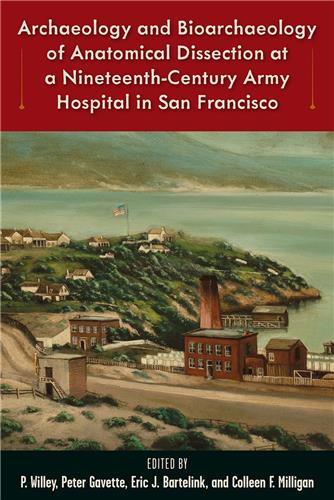Archaeology and Bioarchaeology of Anatomical Dissection at a Nineteenth-Century Army Hospital in San Francisco
Edited by P. Willey, Peter Gavette, Eric J. Bartelink, and Colleen F. Milligan
Foreword by Kenneth C. Nystrom
Hardcover: $90.00
An archaeological site that tells a story of structural violence in medical research
“Represents an impressive use of modern forensic and bioarchaeological methods to reveal a great deal of important information about American history during the post-Civil War period, particularly as it relates to the history of medicine. Nuanced, sensitive, and reflective.”—Debra Martin, coeditor of Bioarchaeology of Frontiers and Borderlands
“A fascinating and exhaustive analysis of anatomized remains and their role in nineteenth-century medical practice. A must-read for anyone interested in histories of medicine and regimes of knowledge, structural inequality, and critical reflections on the future of the discipline.”—Meredith Reifschneider, San Francisco State University
“Provides a wide-ranging overview of this discovery of dissected human skeletal remains. In addition to expert analyses of the human remains and associated artifacts, historical sleuthing reveals details about the Army surgeon whose dissections and autopsies most likely produced the medical waste pit.”—Thomas A. Crist, Utica University
In 2010, a pit containing over 4,000 human skeletal elements was discovered at the site of the former Army hospital at Point San Jose in San Francisco. Local archaeologists determined that the bones, which were found alongside medical waste artifacts from the hospital, were remains from anatomical dissections conducted in the 1870s. As no records of these dissections exist, this volume turns to historical, archaeological, and bioarchaeological analysis to understand the function of the pit and the identities of the people represented in it. In these essays, contributors show how the remains discovered are postmortem manifestations of social inequality, evidence that nineteenth-century surgical and anatomical research benefited from and perpetuated structural violence against marginalized individuals.
P. Willey is professor emeritus of anthropology at California State University, Chico. Peter Gavette is an archaeologist at the Golden Gate National Recreation Area. Eric J. Bartelink is professor of anthropology at California State University, Chico, and coauthor of Forensic Anthropology: Current Methods and Practice. Colleen F. Milligan is professor and chair of the Anthropology Department at California State University, Chico.
A volume in the series Bioarchaeological Interpretations of the Human Past: Local, Regional, and Global Perspectives, edited by Clark Spencer Larsen
- Sample Chapter(s):
- Table of Contents
- Excerpt
There are currently no reviews available












